Soft4Sense
Smart Surfaces for Reliable Tooling Integration
Challenge
Use of PVD sputtering thin-film technology for miniaturization of sensors, for direct application in mechanical components subjected to high external loadings, and evaluate the materials parameters exactly where they must be measured. Optimization of the process to improve the mechanical and electrical integrity of these devices, allowing their reliable and reproducible production and utilization.
Solution
The proposed solution is a software that can help to deposit the multilayer stacking with the appropriate conditions for achieving a reliable and reproducible product. The aim is the development of a software solution that can help deposit multilayer systems for a reliable and reproducible product by indicating the correct deposition conditions. This simple program, with the information about the required characteristics of the stacking layers (e.g. residual stress level, defects density, electrical characteristics, hardness, Young´s modulus), supplies the deposition conditions for the stacks fabrication.
Objectives, Activities and Results expected / achieved
Final Objectives:
1. Development and optimization of new materials in thin layers that can be integrated into a multilayer system with sensitive properties. Understand the contamination level between the interfaces and its effect on the interfacial delamination of the complete stack.
2. Development of a model to predict the thermomechanical reliability of the stack considering the materials' properties and target application. Correlation between the model output and the residual stress levels. Adapt deposition conditions to comply with the model output.
3. Experimental analysis on the thermoresistive properties of the functional layer and how they are affected by the multilayer approach integration.
4. Selection of a target application for service testing the multilayer system.
Final Outcomes:
1. Multilayer system deposited on service substrates with mechanical integrity to support the external load, with electrical characteristics suitable for temperature assessment.
2. Methodology for surfaces and interfaces preparation and complete structural and chemical knowledge of the interfaces between the layers in the stacks.
3. Computation of normal and shear stresses in multilayer stacking and single layers, and machine learning model to predict Young's modulus and the yield strength.
4. Temperature measuring in real-time and data transmission during machining operations.

Project Reference
POCI-01-0247-FEDER-045921Funding

Intervention Region
North (32,08%) and Center (67,92%) of PortugalTotal Investment
971.167,64IPN Investment
304.676,22Total Eligible
971.167,64IPN Eligible
304.676,22EC Funding – Total
727.142,94EC Funding – IPN
228.507,17National public financial support – Total
244.024,70National public financial support – IPN
76.169,05Duration
39 MonthsStart Date
2020-04-01End Date
2023-06-30Approval Date
2020-02-14Consortium
TEandM – Tecnologia, Engenharia e Materiais S.A.Instituto Pedro Nunes
International Iberian Nanotechnology Laboratory
Partners
University of Texas at AustinKeywords
Simulation software;Multilayer thin-film;
Sputtering;
Functional surfaces.










